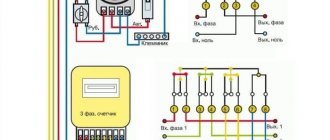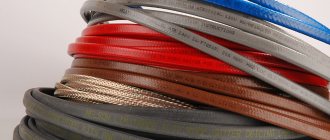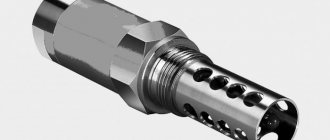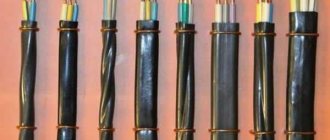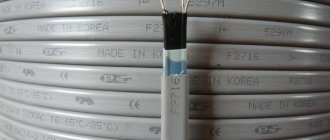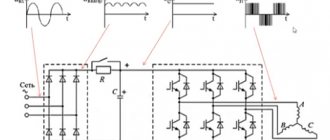When building a house without the help of specialists, not every owner takes into account climate changes throughout the year, so they forget to lay a heating cable for the water supply if it is installed above the freezing depth of the soil. To do this correctly, we will consider the types of wires, fastening methods, connection techniques and the procedure for thermal insulation. The article provides all this information, as well as a comparative analysis of cables, highlighting the advantages and disadvantages of each installation method.
Installation of cable along the pipe Source obustroeno.com
What is a self-regulating cable?
In many areas, it is necessary to use cable products that respond to ambient temperature without the participation of additional sensors and regulators. A self-regulating cable is just such a device.
It independently changes the heating activity in different zones, taking into account current needs. The colder it is at the installation site, the more the conductor heats up.
To put it simply, this is a structure with two copper wires that conduct electricity, with a heating matrix located between them.
The latter is located throughout the range of the electrical circuit between the supply wires. The purpose of such a matrix is to heat and regulate, and there is a screen on the surface that protects the wire from the influence of the electromagnetic field.
There is another layer on top that guarantees resistance to mechanical damage.
Welding machine as a step-down transformer
When pouring a small volume, the wire for heating concrete can be connected to a powerful welding machine with an output current of 150-250A. This will save on renting a step-down transformer. Let's give an example of how this method can be implemented.
Task: pour a slab with a volume of 3.6 m3, at an air temperature of 10°C.
Required:
- welding machine 200−250A;
- current clamps;
- PNSV wire;
- Automatic reclosure for cold ends;
- fabric-based electrical tape.
PNSV must be cut into segments of 18 m each. Each such segment can withstand current up to 25A. You can connect 10 such segments to a 250A welding machine (25×10=250A). But in order to prevent overload, it is worth leaving some reserve, so we will take 8 segments.
We screw the autorecloser to each output and insulate the connection point. The length of the wire should be enough to reach the welding machine, and the twist itself should be placed in concrete.
Next, the PNSV is laid according to the diagram below. The cold ends are connected by a terminal block ((+) and (-) separately), which is placed on an insulating material, for example, textolite.
Connection diagram of PNSV to the welding machine
Having completed pouring the concrete, we set the minimum current on the welding machine and connect the terminals to its forward and reverse outputs. We measure the current on all segments; it should be no more than 20A. During heating, the current will drop, then we increase it on the device.
Classification and types of self-regulating cables
When choosing a self-regulating heating cable, it is important to consider the type on which the characteristics directly depend. There are several types of such products.
Self-regulating cable without shield
The peculiarity is the absence of an additional outer shell that protects against the influence of the electromagnetic field.
Thanks to this feature, the product loses in price and is more accessible to the buyer. Resistance to mechanical and natural influences is maintained, but protection from electrical damage is lower.
Due to the lack of shielding braid, installation in open areas and places where there is aggressive influence is prohibited.
Models without a screen are installed in areas where there are no UV rays and no risk of mechanical influence. The conductor may be damaged if it is tapped, walked on, beaten, etc. Sold as a cut or included as a set.
Shielded self-regulating cable
A special feature is the presence of a special screen that protects against EM radiation, increasing resistance to external influences. This is a more universal option, presented in several types depending on the scope of application.
Sold as a set, cut or resistive. At the time of sale, they may be classified as products for installation inside or on top of pipes and drains, for roofing, drains, etc.
General purpose self-regulating cable
A separate category includes products that have a general purpose and are not suitable for performing special tasks. There is no normal protection from UV rays or external influences.
For this reason, the products are usually used for heating different types of pipes and drains. Installation on roofs or gutters is prohibited, where there are negative factors that can reduce service life.
Additional classification
When choosing self-regulating cables, it is necessary to take into account their additional features.
They may have the following characteristics:
- explosion protection;
- for low voltage sources.
All products are cut or come in ready-made kits.
The pipe is frozen - the reason
All heating cables operate normally only if the voltage corresponds to the nominal values specified in the product data sheet. If you have problems with the voltage at home, and it rarely rises above 180-190V, then do not be surprised that the selected power may not be enough, and one day the pipe will freeze.
Why does the cable itself sometimes die? Self-regulators are afraid of frequent switching on and off. They usually have a finite number of such switchings.
They also fail due to improper connection to the 220V power cable. Poor quality end seal and moisture getting into the shell are another reason.
To seal the food cable into the pipe, seals are used. When choosing them, pay attention to the shape of the cable. They are round or flat.
They use their own seal for a specific brand. If you choose the wrong one, you will get a leak.
Scope of application
One of the main features of a self-regulating cable is its wide range of applications. It is suitable for heating eaves, water pipes, roofing and gutters, floors and other areas where water cannot be allowed to freeze.
Depending on the features, the following areas of application are distinguished:
- Private sector. It is used in water supply and sewerage facilities to prevent water from turning into ice and damaging pipes.
- Commercial structures. Use in city networks or in other organizations for heating pipes, arranging fire extinguishing systems.
- Industry. This category includes special heating cables that can operate in more severe conditions.
Where are heating systems used?
The scope of application of heating cables for pipes (and not only) is quite large. They are installed in places where controlled heating of adjacent (surrounding) surfaces or materials is required.
Some types of cable are specifically designed for underfloor heating systems. They are laid under ceramic tiles, boards, laminate, carpet, and sometimes filled with concrete screed.
The last option is the least effective, since the screed “steals” heat, and only part of it passes through the finishing coating.
Layout of the heating cable in the bathroom using the “warm floor” system. The wire is placed in a “snake” across the entire area of the room so that the two ends are in opposite corners
Cable heating is common in water supply and sewerage systems. Communications buried in the ground or passing above the ground in the northern regions of Russia are at risk of complete freezing for six months - from October to April.
If the pipeline is laid above the freezing level of the soil and is not insulated enough, it will quickly lose its functionality. Therefore, we recommend that you learn more about the types of heating cables for heating water pipes.
A heating cable fixed to the pipe will help replace the heat-insulating “cocoon”. There are different installation methods, the most common are linear and spiral. The second covers a larger pipe area
If the pipes are already buried in trenches and dismantling is impossible or undesirable, the cable is installed inside the water (sewer) pipe through a tee cut into the most convenient place.
The next application of self-regulating cable is heating systems for roofs and gutters.
The wires are secured in a special way at the edges of the roof, in trays and gutters, and in drainpipes. They prevent the formation of ice, which destroys drainage systems
Under the influence of high temperature, snow and ice gradually turn into water, which flows down through trays and pipes. Roofs become safe for people and vehicles in the yard.
A practical use of heating cables for those who do not like fogged windows and mirrors is to mount the samreg on the back of the mirror, after which condensation will no longer bother you.
In production and during construction work, heating is often necessary to help “ripen” concrete solutions.
In order for the characteristics of the finished material to meet the standards, it is necessary to create a special temperature regime. For this purpose, self-regulating cables are evenly placed in the place where the solution will be poured, and fittings are used to fix them. After hardening, they remain inside the structure
The situation is similar with liquids, for which samregs are also used to maintain a certain temperature. Instead of heating a reservoir with a technical liquid in the traditional way, a cable is lowered into it; as a result, the characteristics of chemical or food solutions do not change for some time.
Heating systems have not bypassed the agricultural industry either. The cable is placed directly into the soil, under the top nutrient layer, which protects the roots of the crops from freezing.
Manufacturers
The high demand for such products has led to the emergence of many companies engaged in the manufacture and sale of self-regulating cables.
Such products are manufactured in the USA, South Korea, Japan and a number of other countries.
Main manufacturers:
- South Korean company E&S Tec.Co.Ltd. They produce products for installation inside and outside pipes, for sewerage systems, gearboxes, gas pipelines, roofing, etc. Its self-regulating products are of high quality and have a service life of about 15 years. The products of this company are suitable for private and industrial heating.
- Heating Lux PSK is a Russian company engaged in the production of various types of heating cables. The finished products are characterized by a long service life, thoughtful design, and high quality of the materials used.
- Lavita is a large South Korean company with many branches in the Russian Federation and other countries. One of the activities is the production of self-regulating cable products. Finished products are fully certified, have a long service life and minimal energy consumption. They are used for heating containers and pipelines, and also as protection against ice formation.
- Raychem is a Belgian manufacturer that produces high-quality self-regulating cables with a service life of at least 40 years. They are economical, have no risk of overheating, are easy to mount and have a wide range of applications.
- Shtein is a well-known German manufacturer that produces products for protecting pipes from freezing. Heating cables are sold in coils and have a warranty period of 5 years or more. Depending on the design, they are used for external or internal installation. They have a shielding layer and additional protection on the surface. They are used in industry, construction and everyday life.
Other manufacturers of self-regulating cables have gained no less popularity. The category of popular ones includes the following companies - Aura, Devi, Rexant, Belamos, Extherm, Teplolux, Fine Korea, Heatline and others.
Why heat up concrete?
When the air temperature is below zero, the mixture partially freezes instead of completely hardening. When it gets warm, the thawing process begins, as a result of which the concrete can collapse, which will negatively affect the solidity of the entire structure. Water will penetrate into the cracks that form, which will lead to a decrease in the service life of the building.
The result of pouring concrete in the cold
To prevent such consequences, it is necessary to organize concrete heating in winter. In this case, its structure will not be damaged, and the constructed structure will be durable.
Design features
Functional features and a wide range of applications are due to the thoughtful design of heating cable products.
The self-regulating cable consists of the following elements:
- A pair of copper veins. They run along the entire length and play the role of a current conductor.
- Heating matrix. This is the main element of the product, providing a change in the heating level depending on the ambient temperature. The element is located parallel between the wires, providing regulation and change in temperature conditions.
- Insulating layer. To increase the level of thermal protection, several layers of insulation are used.
- Shielding braid. It is made of metal and provides protection against EM and mechanical influences. This element of the cable product is grounded, providing additional protection against damage by electric current.
- Outer shell. Mandatory coating that protects the self-regulating cable from various types of damage.
Thanks to this design, the self-regulating cable is resistant to various types of damage and can serve for many years without the need for maintenance.
But we note that the composition of the heating conductor may vary depending on the purpose (with or without braided shielding). The characteristics of the protective shells and the diameter of the conductive cores also differ.
Operating principle
After studying the design features, a question arises about the principle of operation of self-regulating heating cables. It works on the principle of a conductor in an electrical network.
Heating leads to an increase in resistance, and the higher this parameter, the less current. As a result, wasted power is reduced and electricity costs are reduced.
If a section of cable passes over a cold section, the resistance decreases and higher current flows through the embedded matrix. This leads to heat generation and frost protection.
As the temperature rises, the current flowing through the mentioned node also increases. In other words, when the self-regulating conductor is turned on in the cold, it operates at maximum power, but as the nearby area heats up, this parameter gradually decreases.
The heating cable operates continuously and does not turn off when the temperature drops. All that changes is the heating level of the product.
On average, the power parameter of such a product is 10-20 W per 1 meter of length. But there are also products that consume up to 150 W. This is a low parameter that you can afford in the winter to avoid even greater expenses.
It is worth remembering that the resource is limited, so when heat sets in, the self-regulating conductor can be turned off.
Shutdown can be done manually or using automation (relays, thermostats). Such devices monitor temperature changes and supply voltage when the temperature drops.
But the installation of such equipment is not necessary, because the cable itself controls the heating level and when the temperature rises, it switches to the mode of minimum energy consumption.
Installation methods: why malfunctions occur
If it is necessary to lay it on flat surfaces, the cable is first unwound; if the work is carried out at low temperatures, then it is necessary to bring the wires into the room and wait until the cable becomes elastic.
Plastic clamps, ties, and brackets are used to secure them to the plane. In concrete products, you will have to pre-drill holes for subsequent tightening of anchors or installation of plastic dowels.
If during the laying process you have to connect fragments of the cord, then be sure to use heat-shrinkable sleeves (tubes). They are placed on the wire until the contacts are twisted, then they are pushed onto the exposed fragment and heated with a hair dryer or gas burner. This ensures complete tightness of the connection.
The thermostat is installed near the electrical panel, and a heating cable is connected to it. To ensure safety, an auto-shutoff device can be used, which is activated in the event of a short circuit or overheating.
If you need to provide heating for pipes, you should choose one of two options:
- Placing the cable outside.
- Laying the wire inside.
Installation when choosing the first method is easier, but there is a risk of damage to the cable during installation, and the heating efficiency of the liquid itself will be lower. To increase the temperature, you will have to wrap the pipe with insulation.
If installation is carried out on the surface, it should be taken into account that some pipeline elements are replaceable (taps, sensors, meters). In such places it is not recommended to lay the wire in a spiral; be sure to loosen the tension (make a loop) so that you do not have to cut the cord if you need to replace the plumbing element.
If the wire needs to be laid inside, it is important to choose the appropriate diameter of the cord, otherwise the water pressure will be significantly reduced. The main disadvantage of such installation is the complexity of the work, the need to use seals and special cords.
Installation of heating cable for the floor.
For installation in pipelines, it is necessary to use “food grade” cables. Their braid should consist of polyolefin, which does not emit harmful substances.
The cable stopped heating, possible reasons:
- The problem is caused by the cord itself. It is necessary to measure its resistance using an electrical tester (multimeter). The value must not be zero.
- The voltage in the house is below nominal. In this case, the cable will not work effectively.
- The automatic shut-off device has tripped or is faulty. Check the condition of the unit, if necessary, eliminate the short circuit.
- The contacts in the shield are oxidized and damaged. The connections should be restored by first cleaning them. To protect against oxidation, special varnishes are used.
Expert opinion
Torsunov Pavel Maksimovich
If the problem cannot be resolved, then the problem may be complex. It is necessary (if possible) to disassemble the electrical heating system and identify defects.
What is the difference from resistive cable
The main feature of a self-regulating heating product is the ability to change the temperature depending on the environment. Resistive models cannot do this and operate in one mode.
Against this background, we can highlight a number of features of self-regulating heating cables that allow you to make a choice in their favor:
- Economical. Unlike resistive “brothers,” self-regulating cables change power depending on temperature conditions. At the same time, you can save money on the purchase of thermostats, sensors and other control elements. It is enough to simply connect the product to the network for it to complete the task. Despite the higher cost, in the long run, a self-regulating cable pays for itself faster.
- Safety of use. Using resistive cable carries the risk of overheating some areas that do not require increased temperature. As a result, the entire system may fail. A self-regulating cable is more flexible because its temperature varies in different areas depending on environmental conditions. In an area with a higher temperature, the heating level is reduced, which helps protect the area from possible overheating.
- Reliable protection. A prolonged increase in voltage can lead to failure of the resistive cable. Self-regulating products are not afraid of such risks.
Other differences from the resistive version also stand out - improved strength characteristics, the possibility of overlapping wires in different areas and ease of length adjustment.
In comparison, resistive cables are typically sold in fixed lengths with no option for shortening. This parameter is limited to 150 m, which must be taken into account during the installation process.
Results: how to choose the right one
To ensure efficient and economical heating of an object, you need to take into account its dimensions, the conditions under which the cable will operate, the power of the wire, and the operating temperature. The quality of the insulation should also be taken into account. For outdoor installation, be sure to use a cord with durable braiding. And in order to prevent interference with electrical appliances near residential premises, the cable must be equipped with a screen, which will also allow the system to be grounded.
All heating wires sold in the country must undergo mandatory certification.
Criterias of choice
When purchasing a self-regulating heating cable, there are a number of criteria to consider.
Let's highlight the main ones:
- Price. Depending on the manufacturer and design features, the price of such products also varies in a wide range - from six dollars per meter and above.
- Manufacturer. It was noted above that companies from many countries are engaged in the manufacture of such products - Russia, Denmark, South Korea, China, Germany and others. The range of products is wide enough to make a choice.
- View. On sale you can find cable products complete and with the possibility of cutting. Screened and non-screened versions are also available.
- Installation. When choosing, take into account the installation location - outside or inside the pipe. There are also universal models that allow installation anywhere (without special requirements).
- Scope of application. As a rule, self-regulating conductors are used for heating pipes, open areas, areas under screed or under tiles. But the scope of its application is not limited there.
- Power. The parameter varies over a wide range depending on the application. The power range is between 15 and 13,500 W.
- Voltage. Mostly self-regulating products are available for sale, designed for a voltage of 220 V. In rare cases, cables for 380 V are produced.
- Length. Unlike resistive versions, self-regulating models can be cut off. In this case, the length can be from one meter or more.
- Heat transfer regulation. Some models provide adjustment of the heat output level. Its presence leads to a general increase in price, which must be taken into account when purchasing.
- A fork is included. There are several options here - euro, Schuko or no plug.
Taking into account the above criteria, you can quickly select a self-regulating cable for the given parameters, requirements and scope of application. However, keep in mind that prices vary widely depending on characteristics, type, manufacturer and other factors.
Best options
The main differences are power, resistance to heat, and the permissible section length during installation while maintaining the permissible temperature regime. Manufacturers also provide different warranty periods for their products.
Resistive
There are single-core and double-core. When choosing the first option, you need to take into account: such a conductor will produce strong interference, so when installing it near the house, you need to choose a cord with a screen.
PNSV
A special cable designed for heating concrete. Single-core, unshielded.
Characteristics:
- diameter – 1.2 mm;
- operating temperature – from -60 to +50 degrees;
- conductor resistance – 0.15 Ohm/m;
- temperature during installation – not lower than -25 degrees;
- approximate consumption – 50-60 linear meters per cubic meter. m of solution.
Warranty – 1 year.
Ceilhit PV R 0.068 Om/m
Designed to maintain positive temperatures of the floor or ground under refrigeration chambers. Supplied in reels or skeins.
Characteristics:
- core resistance – 0.068 Ohm per meter;
- section power – from 1 to 15 W per meter;
- supply voltage – 220-230 V;
- operating temperature of the internal core – up to 75 degrees;
- shell temperature – up to 60 degrees;
- cord bending radius – from 30 mm;
- cable laying pitch – from 60 mm.
The manufacturer does not recommend laying the wire at temperatures below -5 degrees.
xLayder 40R-20
Ready-made kit for industrial use - heating concrete. Two-wire, there is a screen. No external transformer is required to connect to the network.
Characteristics:
- length – 20 m
- power – 40 W per meter;
- total cable weight – 1.5 kg.
Manufacturer's warranty – 1 year.
SpyHeat SHFD-13-300
Designed for installation along or inside pipelines for various purposes. Twin-core, shielded. The built-in thermostat automatically turns on the system when the temperature drops below +5 degrees. The kit is ready for installation.
Characteristics:
- total length – 23 m;
- thickness – 8.5 mm;
- power – 300 W per meter;
- voltage – 220 V.
Manufacturer's warranty – 730 days.
Freezstop Simple Heat 18-19
Designed for heating the pipeline. Ready for installation. The kit includes a thermostat that supplies power when the system cools below +5 degrees.
Characteristics:
- length – 19 m;
- power – 18 W per meter;
- bending radius – from 50 mm;
- surface temperature – from 65 degrees;
- installation is carried out at temperatures from -15 degrees;
- voltage – 220 V;
- The outer shell is elastic plastic.
Warranty period – 1 year.
Self-regulating
Most often - two-core. Inexpensive wires are supplied without shielding braid, which causes restrictions - in some cases they cannot be used in production and construction sites.
SRL/GWS/SRF 16-2
Twin wire. Designed for heating pipes, water pumps, containers, drains, roofing surfaces, greenhouses, artificial and natural lawns, stair steps, ramps, open areas, railway switch mechanisms, concrete poured into formwork, electric heated floors.
Characteristics:
- power supply voltage – 220-240 Volts;
- dimensions (width x thickness) – 11 x 5 mm;
- exposure temperature – up to 85 degrees;
- heating temperature: up to 66 degrees;
- electrical equipment class – T6;
- shell type – polyolefin;
- bending radius – up to 25 mm;
- power – 16 W per meter;
- section length – up to 70 m.
Manufacturer's warranty – 24 months.
NONAME SRL 16-2 120004
Universal two-core wire. Copper conductors are covered with a layer of tin, cross-section - 0.75 square meters. mm. Purpose: for heating pipelines.
Characteristics:
- wire dimensions (width x thickness) – 8.11 x 3.22 mm;
- power – 16 W per meter;
- Mains voltage: 220~240 V
- insulation resistance – from 103 MOhm per meter;
- bending radius – from 25 mm;
- screen - no;
- shell – modified polyolefin.
Manufacturer's warranty – 6 months.
STB 16-2
Used for installation on tanks and pipelines. For use in everyday life. There is no shielding layer.
Characteristics:
- permissible temperature of exposure to the surface of the wire – up to 85 degrees
- installation temperature – not lower than -10 degrees;
- heating temperature – up to 65 degrees;
- average power – 16 W per meter;
- system installation length – up to 140 m;
- bending radius – from 50 mm.
Manufacturer's warranty – 6 months.
DINSO PFP-10PR
Designed for heating floors and roofs. Features: minimal power consumption; there is a protective copper braid coated with a thin layer of tin. The shell is not afraid of strong heat and does not emit harmful substances. Minus - unshielded.
Characteristics:
- power – 10 W per meter;
- voltage – 220 Volts;
- bending radius – from 25 mm;
- operating temperature – up to 65 degrees;
- permissible temperature for heating is 85 degrees.
Manufacturer's warranty – 10 years.
SRL 40-2CR UV
Protects walls, roofing, and drainage systems from freezing. There is shielding and an additional shell to prevent mechanical damage.
Characteristics:
- voltage – 220-240 V;
- conductor heating temperature – up to 65 degrees;
- power – up to 40 W per meter;
- surface impact temperature – up to 85 degrees;
- dimensions (width x thickness) – 11 x 5 mm;
- complete length – 200 m;
- External insulation – polyolefin.
Warranty – 7 years.
Advantages and disadvantages
A self-regulating cable is not an ideal product, because it has not only advantages, but also weaknesses.
Advantages:
- Reliability and simplicity of design.
- Uniformity and homogeneity of heating along the entire length with the ability to change the temperature regime in cold/warm areas.
- Resistance to sudden changes in voltage, lack of fear of sudden jumps in this parameter.
- Saving electricity. Even when operating at maximum power, electricity costs will be relatively small.
- Safety. The presence of several protective layers reliably protects against electrical damage. In addition, such products are not afraid of overlap and are reliably protected from overheating.
- There is no need for additional maintenance and costs.
- There are no length restrictions, which allows you to choose a solution for specific situations.
Self-regulating heating conductors also have a number of disadvantages:
- Higher price per meter of product.
- The cable is supplied in large quantities and often without factory couplings and glands for connection. There are also no connecting tubes that you need to connect yourself.
The main disadvantage for many buyers is the cost, but during long-term use the self-regulating conductor is more economical than its competitors. This is achieved thanks to the ability to change power depending on operating conditions.
How to lay a heating cable outside a pipe
For external installation you will need:
- the cable itself
- aluminum tape
It should be tape with a good metallic coating. Cheap lavsan film with a metallized coating will not work.
- nylon zip ties
- thermal insulation
To ensure that the heat is distributed evenly along the entire length, wrap the insulated area with foil tape.
Mistake #6
In this case, there is no need to wrap the entire pipe.
Let's say you have a pipe of one hundred square meters or more. Glue one strip of tape along it and that’s it. It is not necessary to use the material over the entire surface.
Mistake #7
There is no need to wrap steel and copper pipes with tape at all.
This equally applies to metal corrugated ones. Only the top layer will be enough for them.
Next you need to secure the cable.
Mistake #8
Most often this is done with the same aluminum tape.
However, this risks the fact that the wire eventually “bulges out” and begins to move away from the wall, which reduces heat transfer significantly.
To prevent this from happening, use nylon ties. The distance between the ties is 15-20cm.
The cable itself can be laid either in an even strip or in rings around it. The first option is considered more rational for sewerage and small-diameter pipes.
In this case, the overlapped spiral gasket will cost you a pretty penny. But often this is the only way to properly warm a large cross-section pipe in severe frosts.
Mistake #9
When laying the cable in a straight line, it should be placed not at the top or side, but at the bottom of the pipe.
The warmer the water, the lower its density, which means it will rise upward as it heats up. If installed incorrectly, the bottom of the pipe may be cold, and this can lead to freezing, especially in sewer systems.
In them, water flows below. In addition, such pipes are never full.
Another layer of foil tape is glued over the cable.
After that, thermal insulation in the form of foamed polyethylene is put on this entire “pie” (pipe-duct tape-cable-tie-tape).
Its use is mandatory. It keeps all the heat inside and reduces energy consumption.
The thermal insulation seam is sealed with reinforcing tape.
Otherwise, maximum tightness cannot be achieved. If you have a ready-made kit with a plug at the end of the cable, then, in principle, the entire installation is complete. Plug the cable into the outlet and forget what freezing pipes are like once and for all.
Popular models offered by the market: overview of options
The market offers a large selection of self-regulating heating cables from different manufacturers. They differ in design features, cost and other parameters. Let's highlight several popular options.
BSX cable from Thermon manufacturer
This is a standard budget cable consisting of copper bars with a diameter of 1.3 square meters. mm, semiconducting matrix, insulation for heating by radiation, special copper braiding and polyolephrine sheath.
An anti-corrosion fluoropolymer shell is also provided on the surface.
There are four types of cable on sale, which differ in power density.
Buyers have at their disposal conductors for 9, 15, 25 and 32 W/m. Each of the four ratings has two insulation options - fluoropolymer or polyolefin.
The first option costs a higher price, but is more resistant to corrosion and negative chemical influences.
Elektra SelfTec DW
This is a self-regulating heating conductor designed for installation inside a pipe. It is distinguished by a reliable outer layer of insulation made of food-grade polyethylene, which allows the cable to be used in pipes where drinking water passes.
Installation of heating section KDBS
The cable is laid on the reinforcement with a pitch of 70 mm. After installing the formwork and pouring concrete, the KDBS is connected to the electrical network. When the concrete has completely hardened, the cable is disconnected from the power supply, the ends are cut off and left in the monolithic structure.
Recommendations for calculating power and laying heating sections of KDBS:
- As a rule, 1 m2 of heated surface requires 4 m of cable.
- The approximate power for heating 1 m3 of concrete structure is 0.4-1.5 kW. When calculating this parameter, the thickness and material of the formwork, the concrete additives used, air temperature, and wind are taken into account.
- The cable is laid in the concrete mass at a depth of about 20 cm.
- The entire cable must be evenly distributed over the heated surface.
- Crossing the cable is not permitted.
- At the junction with non-thermally insulated surfaces, it is necessary to install another heating section with a separate control system.
- You cannot use the same section to heat two or more objects with different heat transfer conditions.
